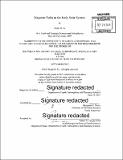Magnetic fields in the early solar system
Author(s)
Fu, Roger R. (Roger Rennan)
DownloadFull printable version (31.23Mb)
Other Contributors
Massachusetts Institute of Technology. Department of Earth, Atmospheric, and Planetary Sciences.
Advisor
Benjamin P. Weiss.
Terms of use
Metadata
Show full item recordAbstract
The first magnetic fields in the solar system were embedded in the ionized gas of the protoplanetary disk itself. Soon after, newly formed protoplanets may have harbored magnetic core dynamos. Paleomagnetic analysis of ancient samples permits direct constraints on these early solar system magnetic fields. Here I present paleomagnetic studies of several classes of meteorites. Experiments on inclusions of chondritic meteorites have led to some of the first constraints on the intensities of protoplanetary disk magnetic fields. Meanwhile, measurements of eucrites, a class of achondrites believed to originate from the asteroid Vesta, suggest that Vesta once hosted a magnetic core dynamo. New techniques developed during the course of these measurements permit ongoing and future investigations of the remanent magnetizations of new meteorites and terrestrial rocks. In support of the paleomagnetic results, I present analytical and numerical modeling of magnetic dust grain dynamics in the solar nebula and of the interior dynamics of differentiated asteroids capable of hosting magnetic dynamos.
Description
Thesis: Ph. D., Massachusetts Institute of Technology, Department of Earth, Atmospheric, and Planetary Sciences, 2015. Cataloged from PDF version of thesis. Includes bibliographical references (pages 251-283).
Date issued
2015Department
Massachusetts Institute of Technology. Department of Earth, Atmospheric, and Planetary SciencesPublisher
Massachusetts Institute of Technology
Keywords
Earth, Atmospheric, and Planetary Sciences.